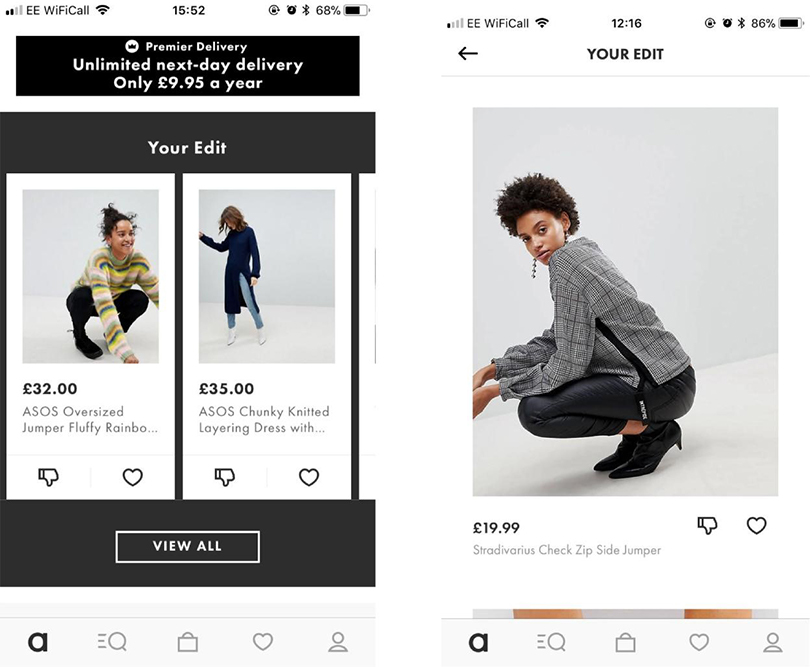


eCommerce development trends in 2018: What the experts think




eCommerce development trends are evolving at a disruptive rate. Meanwhile, statistics are consistently showing that millennials prefer to shop online instead of in-store. As a result, the economic impact of eCommerce is becoming bigger and bigger, and every business needs to keep up - else they'll miss out.
Here are just some of the biggest eCommerce development topics hitting the headlines:
- Can delivery get faster? Can we keep up with the pace of Amazon?
- What is the impact of GDPR? Will it kill off the telesales industry?
- Will the popularity of eCommerce allow smaller fashion brands to flourish?
- Will there be an increase in voice command shopping thanks to smart internet?
- How can Amazon and eBay sellers differentiate themselves and stand out in the marketplace?
- What will be the impact of a ‘soft’ or ‘hard’ Brexit on trading regulations between the UK and the EU?
- Will customer-centric brands selling only a few products prosper?
We asked a handful of experts which trends they thought would have the biggest impact on the eCommerce development landscape. Here's what they said…
 Michael Stewart – Ask MJS
Michael Stewart – Ask MJS
Data and how it can be used to be smarter about how and in what ways you interact with customers on and off your website will continue to become one of the greatest opportunities for eCommerce, and indeed all home-shopping and distance selling businesses.
As a portfolio marketing director I know that too many businesses are unaware of the massive impact and workload that GDPR will cause. The obligations and thinking that needs to be done are significant and too many businesses just think that’s it’s about changing privacy policies. Get on it if you haven’t already.
Steve Flanagan – Big Eye Deers

Knowing your customers and yourselves just got more serious. Tracking a user ID’s behaviour flow or cart abandonment isn’t enough anymore, it’s time to get serious with real-time customisation.
Brand loyalty is decreasing, users want quick and easy solutions that are fuss and hassle free, and if a site can tailor its web store to match those individual's unique needs then we’re onto a winner. Personal relationships are where it’s heading; whereby websites, like friends, know your likes and dislikes and are there to guide you in real-time. Increasingly, retailers are investigating in sophisticated tracking techniques to customise each person’s experience in this manner.
Retailers Amazon and ASOS have great examples of real-time customisation in action. By measuring habits and trends with the intention of promoting related products, and promotions based on browsing habits, they are offering shoppers a personalised experience.

And it doesn’t stop there. Retailers are recording customers’ measurements to suggest clothes that suit their figures, and cosmetic brands are noting unique characteristics allowing customers to browse products suited to their skin tone and lifestyle.
It is well-known that consumers don’t like to be ‘followed’, but real-time customisation offers a transformative new option. The data is used to serve a customer timely, accurate product information – without pressuring them to purchase. It’s a digital way of offering consumers their own personal shopper, that doesn’t obstruct a purchase.
The brands that will gain the most are the ones able to capitalise on the customer-retailer relationship, while fine-tuning the algorithms that serve up relevant content.
History is littered with failed brands that didn’t innovate though. Their stories of success made them complacent, and they began ignoring trend developments and the needs of their customers. The foreseeable future will be full of industry disruptors bringing a fresh approach that smashes industry conformity and sees businesses tap into undiscovered potential.
Uber for example, have ripped up the rulebook on taxi services, taking disruption into the stratosphere. By having a deep understanding of their own core offering – the ability to aid transportation – Uber have expanded into diverse new avenues, including food delivery. And, like Uber many business have began seeking ways to define and preserve their futures using similar methods.
Again, we are welcoming a generation of consumers with decreased brand loyalty and retailers cannot concentrate on the product alone. Brands need to challenge themselves more. They need to behave like hungry startups to identify opportunities in their markets, and in others. If they don’t, someone else will.
Jennifer Gwinnutt – iWeb Solutions
With a distinct shift from desktop to more meaningful mobile engagement, we’ve formed a digital world where eCommerce businesses are expected to be on, open and alert at all times.
For 2018, we think it’s already showing itself to be the year of ‘micro moment’ marketing, where brands must navigate a more complex online terrain in relation to the non-linear customer journey. Now more than ever, customers are demanding different and dynamic online experiences depending on the circumstances they are in and conditions that are affecting them. It’s crucial that we’re always there to respond the right way.
Another consequence of increased mobile engagement has meant it’s changed the way consumers engage with social media. With our pocket computers we’re able to access content at any time and this has created an apathetic audience who are only interested in ‘split second’ experiences. While this makes it harder for brands to grab and keep the audience’s attention, because of this we expect to see brands utilising more dynamic and imaginative online ‘guerilla’ marketing tactics through the medium of video and other types of short form content. In order to stand out on social we expect to see brands pushing the boundaries in terms of brand image, tone, engagement and offering a truly relevant omni-channel experience.
Craig Murphy – ALT Agency

We believe that 2018 will be the year voice search gains some incredible traction. With the popularity with devices such as Amazon Echo and Google Home voice searches will grow. Its reported Walmart has already agreed a deal with Google whereby reordering your shopping through Google home becomes possible – This will only get smarter.
The other impact of voice search is of course on the search results as users often ask long tail questions and only 1 answer is given so optimising for voice is going to be key to be in that spot.
 Matthew Porter – Kumo Digital
Matthew Porter – Kumo Digital
One of the biggest areas for growth in the pay per click (PPC) channel for ecommerce retailers will be the importance of structured data.
Many ecommerce development professionals will be very familiar with the importance of structured data across the sites that they manage, especially product pages to aid with rich snippets or product data to show in organic search engine result pages (SERPs).
However, this data has increasingly been utilised by Google Merchant Centre in conjunction with feed data to monitor certain information on page.
This data may be further utilised for Google Shopping / Product Listing Ad (PLA) campaigns and start to circumvent the data submitted via product feeds or at least increase the amount of data that will be dynamically pulled from landing pages. In addition to this we may start to see further enhanced rich product information being displayed as knowledge graph cards or new features within paid search results.
We may also see more information being utilised from the Google Manufacturer Centre, or at least a deeper sharing of data to Google Merchant Centre as the platform has just been extended to select European countries. Google Manufacturer Centre allows manufacturers to submit rich product information such as product titles, descriptions, images, key features, YouTube videos and other elements not captured in a Merchant Center feed. The data submitted to the Google Manufacturer Center is used to enrich Google’s overall product catalog as outlined here.
Takeaways for ecommerce retailers should be ensuring that they have structured schema markup in place within their sites markup, especially on product pages and within platforms such as Google Manufacturer Center and Google Merchant Centre.
This will not only have some potential SEO benefit, but also have create a potential performance increase in CTR within the SERP’s due to the enhanced and engaging data being displayed such as pricing, stock availability and review ratings. The same applies to PPC, structured data will allow Google to dynamically pull an increased amount of information to display within PLA / Shopping results, along with search results which in turn should impact CTR due to the enhanced user experience.
 Dan Bell – e3creative
Dan Bell – e3creative
With the adoption of voice search devices and more ‘showrooming’ happening when people are in bricks and mortar locations, i think the emphasis is very much on retailers to join the connection between offline and online to be competitive and ultimately provide users with a seamless experience.
The rise in search functionality such as Pinterest Lens and also products being readily sold through Instagram and Facebook, means that retailers also need to look at their wider digital strategy to understand whether they are reaching their consumers at the various different digital touch points on the path to purchase.
Traditional channels of organic and paid search will generally always be strong, but growth and new markets can be reached through more innovative strategies and understanding how these audiences interact with products or services.
 Danielle Horrocks – boxChilli
Danielle Horrocks – boxChilli
Ecommerce development will be more important than ever.
‘Recommended’ ads and ‘thought you might like’ marketing will become even more personalised. Users expect to see not only related, but highly relatable product/service recommendations from their favourite online shops. Now shops need to take it to the next level and start thinking ahead of their customers. Bigger, better data will drive a smarter customer journey – moving away from using “typical buying habits” and moving towards personal recommendations based on individual preferences.
After Google Home hit almost 7 million speaker sales in just 3 months and the Amazon Alexa App store rankings soared, we could see an increase in voice command shopping. Stores may just need to make sure they skip the “clunky” phase and head straight to developing a seamless system to avoid frustrating users.
Virtual reality will also be on the rise. Users have already seen snippets of this technology, but 2018 will see a rise in a much more intelligent use of it. Loreal’s Makeup Genius App is definitely on the way, and a great example. The App aims to inspire users by combining make up testing with Virtual Reality; users can try a wide range of products, wherever they are, whenever they want. The makeup App has been praised for its virtual application and makes it easy for users to buy the products. No matter what the VR type, the end goal will be the same – to provide an enjoyable customer experience that guarantees a sale.
It is estimated that by 2020 mobile will account for 45% of the $632 billion in total eCommerce sales*. (Googles latest SEO algorithm update reflects the estimation. Whilst desktop will not be discounted entirely, Googles algorithm will “primarily use the mobile version of a site’s content to rank pages from that site, to understand structured data, and to show snippets from those pages in our results”.*) This increase in mobile traffic means stores need to understand the importance of designing and creating a user experience that is fully functional on a mobile; website designs will end up being separate from its desktop counterpart. Not only do online shops need to be mobile friendly, they must be mobile first.
 Paul Carmen – insiteweb
Paul Carmen – insiteweb
eCommerce development trends will change dramatically over the course of 2018, accelerating the change that we have already seen happening in recent years. The weaker players, both on the high street and online, will continue to be marginalised; struggling for survival.
With the advent of GDPR, and the changes in what a business can show in the Facebook timeline for free, businesses will be squeezed out and virtually invisible online unless they leverage their paid marketing and customer information properly, with insight and data driven campaigns. The only other viable alternative is to work much harder on local and national SEO, which for many companies is not something they’ve thought about before in any great detail.
 Sophie Heward – Surge Marketing Solutions
Sophie Heward – Surge Marketing Solutions
One significant movement eCommerce websites will have to tackle in 2018 is the introduction of GDPR, which impacts on many marketing techniques.
GDPR basically means that all marketing messages – whether they are sent through email, phone, letter or any other channel – must be consciously agreed to by the recipient before they are sent.
One of the forms of digital marketing expected to be most heavily affected by GDPR is email marketing. For example, personalised marketing emails are often used by eCommerce companies to retarget website visitors who have put products in their basket but not checked out.
These emails act as a reminder, and because the visitor has clearly shown interest, this little nudge often makes the conversion. Now though, these emails are only allowed to be sent to customers who have agreed to them.
This law will have inevitably caused thousands of databases to have a significant decrease in size. However, at least all your recipients will be happy to receive emails about your products and interested in what you have to offer! Some see GDPR as a barrier, but realistically, it’s just allowing your eCommerce website marketing to be much more focused. This should, in turn, allow you to see more positive results.
 Robert Brown – JUMP
Robert Brown – JUMP
As traditional brick-and-mortar retailers continue their decline, eCommerce sales and the trend of buying online will continue to grow due to its constantly improving ease, speed and ultimately, experiential offering.
A lot of this is thanks to mobile shopping – as the ubiquity and power of mobile phones grows we are seeing more mobile-optimised shopping experiences giving users the same features they have grown used to – on the go.
I’m confident that we will continue to march on into our exciting and sci-fi future, with the development of better chatbots and voice-assistance enabled devices such as Amazon’s Alexa and Google’s Home that are allowing users to buy online using nothing but their voice.
And with the introduction of delivery drones, the eCommerce landscape will only keep expanding! eCommerce retailers are going nowhere but forward – and this year we will continue to see an ever-increasing growth in their market share.
 Richard Ellis – Answer Digital
Richard Ellis – Answer Digital
Personalisation of service has been a central tenet of eCommerce development trends in recent years, as retailers move to deliver compelling propositions, capable of developing customer loyalty. We will see this accelerate again through the rise of Artificial Intelligence.
Interaction with Intelligent chat bots is becoming increasingly accepted in the mainstream. The combination of real time interaction with personalised ‘bundles’ of products and services will clearly feature in new conversion strategies.
Competition in final mile propositions will continue to challenge retailers. Specifically, can eCommerce retailers equip themselves, operationally and commercially to compete with Amazon’s services? Customer expectations of fulfilment now form critical elements of competitive advantage. Customers want intuitive digital products and services, with streamlined delivery lead time, cheap, if not free. These are collective pieces of a puzzle which form a significant challenge for eCommerce retailers.
This could be the year browser-less services gain real traction in the retail mainstream. Voice controlled devices saw huge uptake throughout 2017, as the growth of smart home devices expands. Customers are looking for frictionless means by which to access products are services. Retailers will be challenged to consider the impact of how customers browse product ranges and access product data. Convenience is key, and talking to ‘Alexa’ to buy groceries, delivered the same day, could see a seismic shift in purchasing and conversion.
 Steven Wu – R&W Media
Steven Wu – R&W Media
Voice technology such as smart home devices like Amazon’s Alexa is really taking off. More and more of us are doing less ourselves and relying on machines. Consumers speak to their device to search and make purchases directly. Merchants need to ensure their website is fully compatible and optimised for voice search. As voice searches only provide one answer or search result, retailers will be fighting for top position.
There is a gradual drop in click-through on Google for both mobile and desktop. This may be due to Google displaying quick and simple information such as answers to searchers in the form of better instant answers, featured snippets and knowledge graph. With the rise of voice search, we’ll see Alexa steal market share from Google with more simplistic searches. So there be a further reduction in click-through rates from Google this year.
 Andy Clayton – Atelier
Andy Clayton – Atelier
We expect to see more innovation and new UI trends in eCommerce sites as retailers look to make small gains over their competitors through better user experiences.
For instance, Schuh has used user insights to show the most popular filters and categories to make it quicker for users to browse the site.
Also expect to see feature rich landing pages which not only benefit users but can improve SEO. Our favourite site for the latest eCommerce development trends is ao.com, which is leading the way in UX.
 Craig MacCallum – Optiseller
Craig MacCallum – Optiseller
There will be an increased focus on delivery options and availability particularly in the UK where working within the small geographic area allows for quick iterations of new delivery and fulfilment options.
Unfortunately but not too surprising these will be focused around the large cities before being rolled out across the wider country.
Additional dedicated multi retail pick up locations will spring into place similar to Doodle and what used to be Post Office Counters who have shrunk their considerable foot print down over the years.
Multi Retail pick up locations will develop to be run by High street retail who will be glad of the footfall to the their physical store network which will slowly transition to showrooms (with small stock holdings) over the next 3-5 years.
Oh…. and the shift from Large Screen interface to small screen interface to no screen interfaces (PC to Mobile to Echo or Home) will drive some real requirements for enhancement in product data to allow buyers to buy without viewing.

Kathleen O’Connor – KO Consulting
As the dominance of Marketplaces such as Amazon or eBay continues to increase, brands will have to work harder to differentiate themselves.
Amazon’s algorithms favour lower priced items, however planning to win on price alone is a short-term strategy. Unless you’re of a size that can shift huge volumes, winning on price can result in a race to the bottom and lower the value of your brand in consumer’s eyes.
Additionally, without a strong brand there is little to stop cheaper overseas manufacturers reproducing products at a lower cost, making it even more difficult.
A carefully constructed brand that has integrity and speaks to the buyer will be able to differentiate itself from its competitors, adding an intangible value that is hard to replicate by competitors. There is a reason people don’t buy a new Chanel handbag on Amazon – they want the full brand experience and are willing to pay for it. This can be difficult for brands with limited budgets as they may need to invest in selling in marketplaces to ensure volume, but also on their own online and in-store offering to create a full brand experience.
I see an opportunity for brands with a real story and history to differentiate themselves, but also a challenge for new players with limited budgets, who will have to think creatively about their marketing strategy.
 Nina Mack – Worship
Nina Mack – Worship
Mobile revenue has already overtaken desktop for many ecommerce websites. Retailers will continue to focus on improving user experience by making it as easy as possible to buy on mobile, especially with the growth of digital wallets like Apple Pay.
Retailers will also find that the optimisation tools they’re using to collect data need lots of time dedicated to them to extract insight if they are to be useful. This means in-house data analyst roles will become more common, even for smaller retailers.
Daniel Mayhew – Payoneer
In 2017, we had a record-breaking year for cross-border eCommerce sales. We’re optimistic that there are no signs of this slowing, with online cross-border retail predicted to grow at twice the rate of domestic eCommerce – at an annual growth rate of 25% – until 2020.
To support this explosion of cross-border selling, you will see a growing demand for incumbent payment gateways, omni-solutions, and alternative payment methods that provide global solutions. The primary objective for online eCommerce businesses will be to provide overseas customers with a frictionless buying and selling experience.
I also predict we will see more online stores and well-known brands, who have traditionally sold directly on their flagship sites, explore the option of selling on marketplaces as part of their overall customer acquisition strategy.
There is no denying the benefits of selling on marketplaces both domestically and internationally. Selling on a marketplace platform provides low risk, low investment, large customer base, integrated fulfilment services and an entire ecosystem of vendors that provide auxiliary services to help e-commerce stores grow their business, save money and time when selling through marketplaces.
Finally, I predict we will see a push from marketplaces, as a part of their growth strategy, to expand globally, attracting online stores and shoppers from overseas. I can also see entirely new disrupters joining the marketplace ecosystem, offering their unique twists to improve cross-border selling and business.
Predicting future eCommerce development trends
Do you have any predictions for more eCommerce trends we might see in the future? If you do, get in touch, we'd love to hear your thoughts.









